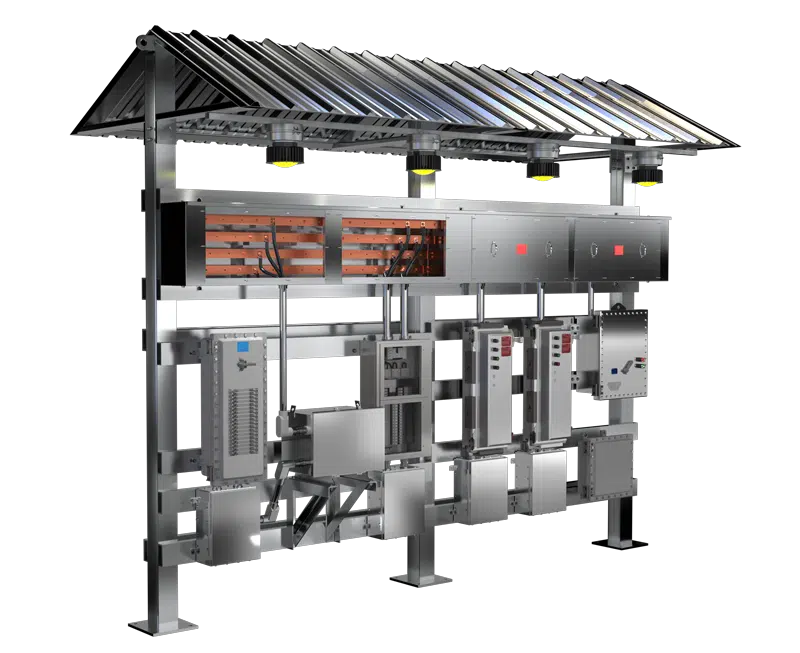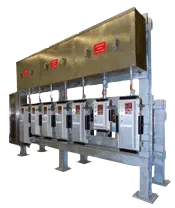Over the past decade, the hazardous location (HazLoc) electrical industry has witnessed a troubling trend—a drift away from rigorous compliance with established IEEE and UL standards. This shift has created an environment rife with substandard installations, posing significant safety, reliability, and economic risks. This blog delves into how the industry arrived at this point, the consequences of ignoring compliance, and strategic solutions to restore integrity and safety in HazLoc switchrack installations.
The Roots of Non-Compliance
Historically, electrical installations within hazardous locations such as petrochemical plants and refineries adhered stringently to standards outlined by authoritative organizations like IEEE and UL. These standards provided clear guidelines for design, installation, and maintenance, ensuring safety and reliability.
However, recent years have seen a market flooded with inadequately engineered, non-compliant switchracks, driven primarily by pressures to cut costs and reduce project timelines. The introduction of products by smaller, less regulated manufacturers and contractors has further exacerbated the problem. These entities often lack the rigorous engineering discipline necessary to meet the stringent demands of hazardous environments.
Common Practices Contributing to Non-Compliance
A particularly concerning trend involves OEMs and smaller electrical contractors attempting to reduce costs by mixing and matching components from different manufacturers, such as Appleton, Killark, Crouse-Hinds, and Adalet. Each of these manufacturers utilizes specific materials, casting processes, and engineering methods for their explosion-proof NEMA 7 Class I Division 1 (C1D1) cast aluminum enclosures. These enclosures are carefully designed, tested, and certified by Nationally Recognized Testing Laboratories (NRTLs), such as UL or Intertek, ensuring they withstand specific explosive conditions.
NEMA 7 enclosures are designed to contain internal explosions without allowing ignition of surrounding explosive atmospheres. Each enclosure and associated control devices—such as handles, pilot lights, disconnect switches, and circuit breakers—are tested and certified as a unified assembly. When manufacturers or contractors interchange parts, for instance using an Adalet handle with a Crouse-Hinds enclosure or an Appleton control device within an enclosure manufactured by Killark, they immediately void the UL or Intertek certification. Such unauthorized substitutions compromise the enclosure’s ability to contain explosions safely, risking catastrophic failures and jeopardizing personnel safety.
Moreover, various companies resort to installing non-tested and non-compliant components such as lighting fixtures, seals, drains, and other accessories, all in an attempt to reduce immediate costs. Typically, smaller, less-informed contractors and “mom-and-pop” businesses engage in these unsafe practices due to insufficient knowledge of electrical codes and standards. Furthermore, these installations are often performed rapidly on-site by contractors lacking proper training and certification, rather than being produced under strictly controlled conditions by ISO 9001-certified manufacturers with robust Quality Management Systems (QMS).
The consequence of these widespread non-compliant practices extends beyond immediate safety concerns. Facilities using improperly certified and mismatched components face increased risks of equipment failure, regulatory non-compliance, and significant financial liabilities stemming from potential accidents or enforced corrective measures by regulatory bodies.
Understanding the Drift
Several factors have contributed to the industry’s drift into non-compliance:
- Cost Pressures: Tight budgets and aggressive competition have pushed companies to seek cheaper alternatives, often at the expense of safety and compliance.
- Lack of Industry Education: Reduced emphasis by major industry players on educating end-users, EPCs, and engineering firms about the importance and nuances of IEEE and UL compliance.
- Reduced Regulatory Enforcement: In some cases, enforcement of compliance has weakened, encouraging substandard installations that superficially meet requirements but fail under operational stress.
Consequences of Non-Compliance
The repercussions of non-compliant switchrack installations are serious and wide-ranging:
- Safety Hazards: Poorly designed switchracks increase the risk of arc flashes, electrical fires, and catastrophic failures, directly endangering personnel.
- Operational Reliability Issues: Equipment failures and unplanned downtime become more frequent, significantly impacting production efficiency and profitability.
- Economic Losses: Facilities facing repeated outages and equipment failures incur escalating maintenance costs, higher insurance premiums, and potential regulatory fines.
Getting Back on Track: The Path to Compliance
Reversing this trend towards non-compliance demands a concerted effort from all industry stakeholders—manufacturers, engineering firms, end-users, and regulatory bodies. Here are several strategic recommendations:
1. Re-emphasize Industry Education
A significant step towards restoring compliance involves reinvesting in education and awareness initiatives. Industry leaders like Spike Electric Controls and major manufacturers must spearhead efforts to educate end-users, EPCs, and engineering firms about the importance and specifics of IEEE and UL standards. Educational programs could include:
- Webinars and seminars detailing compliance requirements.
- Workshops that highlight real-world case studies illustrating compliance versus non-compliance outcomes.
- White papers and technical documentation providing clear, practical guidance on compliant installations.
2. Strengthening Regulatory and Internal Compliance Checks
Enhancing compliance oversight at both the regulatory and organizational levels is essential. Facilities and EPC firms should implement stricter internal review processes and mandate comprehensive factory acceptance testing (FAT) and site inspections adhering to IEEE guidelines. Regulatory agencies should reinforce rigorous compliance enforcement, conducting regular audits to ensure standards adherence.
3. Collaborative Partnerships
Creating partnerships among reputable equipment providers, engineering firms, and end-users ensures uniformity in compliance practices. Collaboration helps establish standardized protocols, design specifications, and installation guidelines. Companies such as Spike Electric Controls offer proven expertise in delivering compliant HazLoc solutions, serving as ideal partners in advocating and achieving compliance.
4. Clearly Defined Engineering Practices
IEEE standards clearly define the necessary engineering requirements for HazLoc installations. Compliant switchrack designs include:
- Structural Integrity: Proper analysis and engineering to withstand seismic and environmental stresses.
- Electrical Design Excellence: Robust bus duct systems, appropriately rated circuit breakers, and fault-clearance mechanisms.
- Area Classification Compliance: Accurate classification (Class I, Division 1 & Division 2) and use of appropriately rated enclosures and conduits.
Spike Electric exemplifies these best practices by consistently integrating these standards into their comprehensive design approach, ensuring every installation achieves compliance and long-term reliability.
5. Encouraging Technological Innovations
Leveraging innovative solutions can streamline compliance while offering enhanced operational efficiencies. Advanced products such as Eaton’s EBMX clamped enclosures and SynergEX stainless encapsulated panel boards represent cutting-edge compliance solutions. These technologies facilitate easier maintenance, reduce downtime, and ensure superior safety and compliance.
Commitment to Compliance: Spike Electric’s Example
Spike Electric Controls has consistently prioritized IEEE and UL compliance, serving as an industry leader in HazLoc switchrack solutions. Their dedication to rigorous engineering practices, stringent testing protocols, and comprehensive education underscores the potential for returning the industry to compliance standards.
Spike Electric’s strategic approach includes:
- Delivering fully compliant turnkey solutions designed explicitly to IEEE and UL specifications.
- Regularly educating clients and industry partners on evolving compliance standards.
- Continuously investing in new technologies to simplify compliance and enhance safety.
- Clearly Defined Engineering Practices
Ensure structural integrity, electrical design excellence, and accurate area classification compliance.
- Encouraging Technological Innovations
Utilize advanced products like Eaton’s EBMX clamped enclosures and SynergEX stainless encapsulated panel boards.
Conclusion: Restoring Industry Integrity
The path back to compliance demands a collective commitment to prioritizing safety, reliability, and engineering excellence. By re-establishing rigorous adherence to IEEE and UL standards, fostering industry-wide educational initiatives, and leveraging advanced technologies, the HazLoc market can effectively reverse the damaging trend of non-compliance.
Industry stakeholders, including reputable firms like Spike Electric Controls, play pivotal roles in driving this change. Together, through committed effort and renewed emphasis on compliance, the industry can restore safety, reliability, and financial sustainability, reclaiming its foundational integrity.



